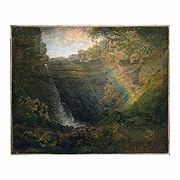
Peter De Wint
Encyclopedia

England
England is a country that is part of the United Kingdom. It shares land borders with Scotland to the north and Wales to the west; the Irish Sea is to the north west, the Celtic Sea to the south west, with the North Sea to the east and the English Channel to the south separating it from continental...
landscape
Landscape
Landscape comprises the visible features of an area of land, including the physical elements of landforms such as mountains, hills, water bodies such as rivers, lakes, ponds and the sea, living elements of land cover including indigenous vegetation, human elements including different forms of...
painter
Painting
Painting is the practice of applying paint, pigment, color or other medium to a surface . The application of the medium is commonly applied to the base with a brush but other objects can be used. In art, the term painting describes both the act and the result of the action. However, painting is...
.
De Wint was the son of an English physician of Dutch
Dutch people
The Dutch people are an ethnic group native to the Netherlands. They share a common culture and speak the Dutch language. Dutch people and their descendants are found in migrant communities worldwide, notably in Suriname, Chile, Brazil, Canada, Australia, South Africa, New Zealand, and the United...
extraction who had come to England from New York., he was born in Stone, Staffordshire
Stone, Staffordshire
Stone is an old market town in Staffordshire, England, situated about seven miles north of Stafford, and around seven miles south of the city of Stoke-on-Trent. It is the second town, after Stafford itself, in the Borough of Stafford, and has long been of importance from the point of view of...
. He moved to London in 1802, and was apprenticed to John Raphael Smith, the mezzotint engraver and portrait painter. He bought his freedom from Smith in 1806, on condition that he supply eighteen oil paintings over the following two years. In 1806 he visited Lincoln for the first time, with the painter of historical subjects William Hilton
William Hilton
William Hilton , was an English portrait and history painter.-Life and work:Hilton was born in Lincoln, the son of a portrait-painter; he may be known as "William Hilton the Younger"...
, R.A., whose sister Harriet he married in 1810. De Wint and Hilton lived together in Broad Street, Golden Square, where John Varley also lived. Varley gave De Wint further lessons and introduced him to Dr Monro, who ran an informal academy for young artists.
De Wint first exhibited at the Royal Academy in 1807, and the following year at the Gallery of Associated Artists in Watercolours. In 1809 entered the Royal Academy
Royal Academy
The Royal Academy of Arts is an art institution based in Burlington House on Piccadilly, London. The Royal Academy of Arts has a unique position in being an independent, privately funded institution led by eminent artists and architects whose purpose is to promote the creation, enjoyment and...
schools. He was elected an Associate of the Old Watercolour Society in 1810 and was made a full member the following year. By that time, as an established drawing-master, he was spending his summers teaching well-to-do provincial families. In 1812 he became a member of the Society of Painters in Watercolours, where he exhibited largely for many years, as well as at the Academy.
De Wint's life was devoted to art; he painted admirably in oils, and he ranks as one of the chief English watercolorists. "No artist", asserted Alfred William Rich
Alfred William Rich
Alfred William Rich , was an English watercolourist, teacher and author.-Life and work:Rich was born between Scaynes Hill and Lindfield in Sussex...
, "ever came nearer painting a perfect picture than did Peter de Wint".
A number of his pictures are in the National Gallery
National Gallery, London
The National Gallery is an art museum on Trafalgar Square, London, United Kingdom. Founded in 1824, it houses a collection of over 2,300 paintings dating from the mid-13th century to 1900. The gallery is an exempt charity, and a non-departmental public body of the Department for Culture, Media...
, the Victoria and Albert Museum
Victoria and Albert Museum
The Victoria and Albert Museum , set in the Brompton district of The Royal Borough of Kensington and Chelsea, London, England, is the world's largest museum of decorative arts and design, housing a permanent collection of over 4.5 million objects...
and The Collection
The Collection (Lincolnshire)
The Collection is the county museum and gallery for Lincolnshire in England. It is an amalgamation of the Usher Gallery and the City and County Museum in such a way that they can work more effectively together than hitherto...
, Lincoln. He frequently visited his wife's home city of Lincoln, and many of his panoramic landscapes and haymaking scenes are set in Lincolnshire. He occasionally toured in Wales, and in 1828 travelled to Normandy.
He died in London.
Selected Paintings
32 Works in Tate BritainTate Gallery
The Tate is an institution that houses the United Kingdom's national collection of British Art, and International Modern and Contemporary Art...
including
- 1810 - Children at Lunch by a Corn Stook, Oil on board - Tate GalleryTate GalleryThe Tate is an institution that houses the United Kingdom's national collection of British Art, and International Modern and Contemporary Art...
, London - 1840 - Roman Canal, Lincolnshire, watercolour on paper - Tate GalleryTate GalleryThe Tate is an institution that houses the United Kingdom's national collection of British Art, and International Modern and Contemporary Art...
, London
External links
- Peter de Wint online (artcyclopedia.com).
- Works by Peter de Wint (Tate online)

